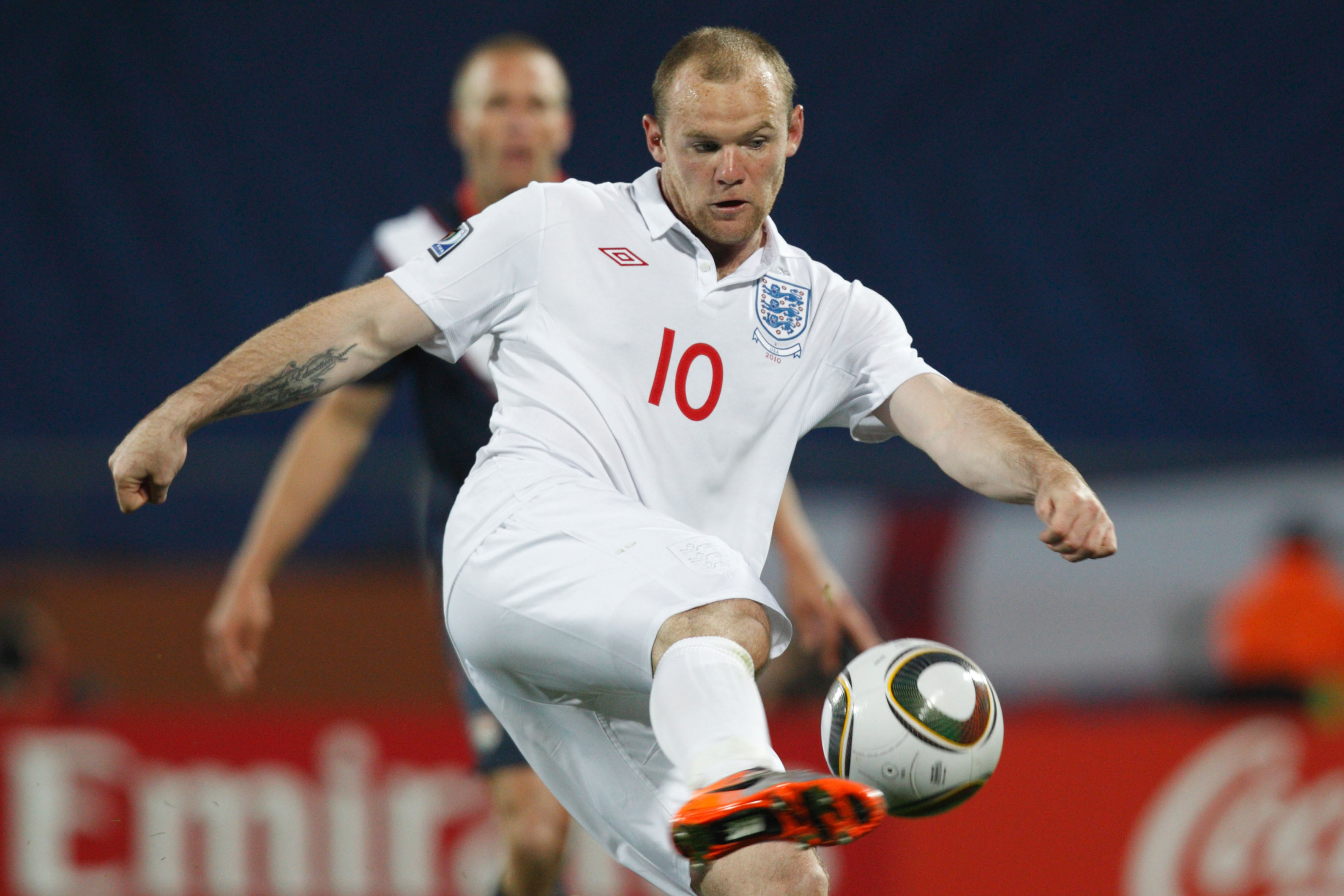
The list of the best English players of the 2010s is bursting at the seams with big names.
In a decade that saw Chelsea, Manchester United, Manchester City and – unforgettably – Leicester win the Premier League title, and England achieve their best World Cup performance since Italia '90 by reaching the 2018 semi-finals, these stars shone brightest.
Let's get straight to it, shall we?!
A product of Manchester United’s youth system, Danny Welbeck made more than 100 appearances for the Red Devils before leaving for another Premier League giant, Arsenal, in 2014.
Tirelessly hard-working with a knack for scoring important goals, the striker – a league champion with United and an FA Cup winner with the Gunners – scored 16 goals in 42 caps for England, featuring at the 2014 and 2018 World Cups.
Promoted to the top flight with Hull in 2016, Harry Maguire quickly established himself as one of the best young central defenders around, earning a big move to Leicester in 2017 and an even bigger one to Manchester United two years later.
The latter transfer, worth £80m, made Maguire the most expensive defender of all time – and by then, he was also a major part of the England set-up, starring in their run to the semi-finals of the 2018 World Cup and scoring (with a customary thumping header) in the quarter-final win over Sweden.
Versatile enough to operate effectively at centre-half in a four or three, or as a defensive midfielder, Eric Dier grew up in Portugal and broke through at Sporting Lisbon – where Tottenham spotted his potential in 2014, signing him for £4m.
That proved to be a bit of a bargain for Spurs, where Dier – a key member of the England side that reached the 2018 World Cup semis, scoring the decisive penalty in the last-16 shootout win over Colombia – made 365 appearances and helped them to the 2019 Champions League final under Mauricio Pochettino.
After showing prodigious talent at boyhood club Southampton, Alex Oxlade-Chamberlain joined Arsenal for £12m in 2011 – and he continued in true wonderkid fashion, becoming the youngest English goalscorer in Champions League history when he netted against Olympiacos shortly after his 18th birthday.
A three-time FA Cup winner with the Gunners, the adaptable attacking midfielder – who was capped 35 times by his country – later helped Liverpool to Champions League glory.
Manchester United’s Players’ Player of the Year for 2015/16, prime Chris Smalling was one of the best centre-backs in the business.
A two-time Premier League champion with Sir Alex Ferguson’s Red Devils earlier in the decade, Smalling earned 31 caps for England, representing the Three Lions at the 2014 World Cup and Euro 2016.
England’s clear first choice between the sticks from 2018 onwards, Jordan Pickford produced some real heroics during his country’s run to the last four of that year’s World Cup – most notably saving a penalty as the Three Lions beat Colombia to record their first shootout win in 22 years.
Signed by Everton for an initial £25m from Sunderland in 2017 – making him one of the most expensive goalkeepers in history – Pickford also helped England to penalty victory over Switzerland to secure third place in the 2018/19 Nations League, smashing in a kick of his own in that shootout.
Pint-sized poacher Jermain Defoe ended his long career on 162 Premier League goals – and he scored a good chunk of them in the 2010s, beginning the decade with Tottenham then notching 15 in successive seasons for Sunderland following a brief stint in MLS.
Defoe also registered nine of his 20 England goals during that decade, the most important being the winner against Slovenia to secure progression to the last 16 of the 2010 World Cup.
Capable all along the left flank, Ashley Young enjoyed the best years of his career at Manchester United – where he arrived from Aston Villa in the summer of 2011.
Part of Sir Alex Ferguson’s final Premier League title-winning team in 2012/13, Young stood out for his combination of defensive aggression and offensive aptitude, proving to be one of England’s key players at the 2018 World Cup – despite some criticism of his selection at the age of almost 33.
Bursting onto the scene as an 18-year-old, Marcus Rashford rapidly (quite literally, such is his blistering pace) established himself as a firm fan favourite at Manchester United.
Proving himself a threat across the front line, Rashford was an England regular while still in his teens and became the youngest player to score on their senior Three Lions debut – finding the net against Australia four months short of his 19th birthday.
One of the most enduring players of the Premier League era, James Milner made his debut as a 16-year-old for Leeds back in 2002 – and he’s still going strong, now at Brighton, at the time of writing.
The 2010s saw the ever-committed utility man win two Premier League titles with Manchester City and the Champions League with Liverpool – among other honours – as well as taking his England caps tally to 61.
A centre-back very much in the continental mould, John Stones brought tremendous composure and superb all-round defensive ability to Manchester City and England during the latter part of the 2010s.
One of the first names on Gareth Southgate’s teamsheet at international level, the former Barnsley man left Everton for City in 2016 in a £47.5m move; he had his first two Premier League winner’s medals before the decade was out.
In 2018, Kieran Trippier scored the free-kick that England fans thought (hoped) would take their country to a first World Cup final since 1966. It wasn’t to be, but that memorable goal against Croatia exemplified what an important player the flying full-back had become for his nation.
Starring for Burnley, Tottenham – who he helped to the 2019 Champions League final – and Atletico Madrid over the course of the 2010s, Trippier showed great versatility by performing strongly in both full-back and wing-back positions.
Technically proficient and defensively robust in equal measure, Gary Cahill joined Chelsea from Bolton in 2011 and went on to become a bit of a legend at Stamford Bridge.
Crucial to the Blues’ first Champions League triumph of 2011/12, as well as starring in two Premier League title victories, Cahill was a mainstay of the national team throughout the 2010s and appeared at two World Cups.
When 18-year-old Luke Shaw left Southampton for Manchester United in a £30m deal in 2014, he became the most expensive teenager of all time.
And the attack-minded left-back – who had made the previous season’s PFA Premier League Team of the Year – lived up to his huge promise, establishing himself as one of the world’s best in his position, winning United’s fan-voted Sir Matt Busby Player of the Year award in 2019, and becoming an England regular.
Manchester City and England’s number one for most of the 2010s, Joe Hart was up there with the game’s finest goalkeepers at his peak – certainly in a shot-stopping capacity.
Recipient of the Golden Glove for the most Premier League clean sheets on four occasions between the 2010/11 and 2014/15 campaigns, Hart starred in City’s first two Prem title successes, as well as helping them to FA Cup and League Cup glory.
Another standout left-back of the 2010s, Leighton Baines spent the entire decade at Everton – where he retired in 2020.
A reliable creative outlet with world-class set-piece ability, the 30-cap England international – who made the 2011/12 and 2012/13 PFA Premier League Teams of the Year – provided 53 Prem assists in all, a record for a defender at one point.
At the time of his retirement in 2020, Gareth Barry held the record for the most Premier League appearances with 653.
And such longevity was a mark of his quality in the defensive midfield role – which the 53-time England international showed to especially impressive effect with Manchester City, where he won the 2010/11 FA Cup and 2011/12 Premier League title, and Everton.
If not for the injuries which so cruelly ravaged his career, Jack Wilshere would be even higher up this list, but he did more than enough in an Arsenal and England shirt to be regarded as one of the most gifted midfielders of his generation.
Voted 2010/11 PFA Young Player of the Year, Wilshere – a two-time FA Cup winner with the Gunners, where he broke through as a 16-year-old – earned high praise from world-class contemporaries like Bastian Schweinsteiger and Gennaro Gattuso.
Prime Daniel Sturridge was one of the most clinical finishers in world football, peaking with 24 goals in 33 games for Liverpool in 2013/14 – when he struck up a formidable strike partnership with Luis Suarez which almost fired Brendan Rodgers’ side to the Premier League title.
A European champion in his final season with the Reds, 2018/19, under Jurgen Klopp, Sturridge struggled with injuries but still made his mark at international level – memorably scoring a stoppage-time winner against Wales at Euro 2016.
Considered one of the best young players in world football when he was tearing it up for Tottenham in the latter half of the 2010s, Dele Alli scooped back-to-back PFA Young Player of the Year awards in 2016 and 2017.
An attacking midfielder or second striker with great goalscoring prowess, he starred for England at the 2018 World Cup and won Match of the Day’s 2015/16 Goal of the Season prize for a frankly outrageous, self-created volley for Spurs against Crystal Palace.
Theo Walcott was a household name by the start of the 2010s, having gained a wonderkid reputation as a teenager – and it was a reputation he lived up to throughout that decade, leaving Arsenal for Everton in 2018 after bagging 108 goals in 397 games.
A speedy and devastating winger in his prime, Walcott lifted the FA Cup twice with the Gunners and represented England at Euro 2012.
Simply one of the greatest left-backs of all time, Ashley Cole was still close to the peak of his powers in the early 2010s.
Included in the 2010/11 PFA Premier League Team of the Year and a mainstay of Chelsea’s 2011/12 Champions League-winning team, Cole continued to represent England until 2014 – when he earned the last of his 107 caps.
Shrugged aside as a somewhat dispensable player early in his career, Jordan Henderson silenced his critics by establishing himself as one of the world’s best box-to-box midfielders in his prime.
Captain for Liverpool’s 2018/19 Champions League and 2019/20 Premier League triumphs – being named FWA Footballer of the Year for his pivotal role in the latter success – Henderson was one of the first names on the England teamsheet towards the end of the decade, starring in the run to the 2018 World Cup semis.
When Jamie Vardy spearheaded Leicester to their against-all-odds 2015/16 Premier League title triumph – scoring in a record 11 consecutive game along the way – he completed one of football’s great fairytale stories, having been playing part-time football just six years earlier.
An unstoppable striker in full flow (not least because of his immense pace), the 26-cap, seven-goal England international rounded off a stunning individual campaign by winning the prestigious FWA Footballer of the Year award – and he was closing in on the 100 top-flight goals mark by the end of the 2010s.
Frank Lampard began the 2010s at the peak of his powers, finding the net a career-high 27 times in 2009/10 as he won his third and final Premier League title with Chelsea – two years before helping the Blues to Champions League glory.
One of the game’s great goalscoring midfielders, Lampard earned his 106th and final cap for England in 2014 – having notched his 29th and final international goal the previous year.
Lampard’s elite midfield contemporary, Steven Gerrard also hung up his international boots in 2014, having amassed 114 caps – and captained his country at Euro 2012 and the 2014 World Cup.
England’s 2012 Player of the Year, the legendary Liverpool skipper was included in the PFA Premier League Team of the Year for the eighth and final time in 2013/14 – his penultimate season with the Reds, when he came so agonisingly close to winning the title that eluded him.
Manchester United’s metronomic midfield maestro, Michael Carrick might be one of the most underrated English players of the modern era.
A five-time Premier League champion with United – winning the last of those titles in 2010/11 and 2012/13 – Carrick went on to captain the club, and he would surely have gained many more England caps had he not had to compete with Lampard and Gerrard (he ranks slightly higher than those two as he kept playing at the top level for a couple of years longer into the 2010s).
Arguably the greatest defender in Premier League history, John Terry kept turning in fantastic captain’s performances for Chelsea until his departure in 2017 – after 19 glittering years at Stamford Bridge.
An England international until 2012, Terry kept picking up winner’s medals with the Blues well into the 2010s – winning three Premier League titles, including one in his final season, two FA Cups, two League Cups, the Europa League and, most significantly of all, the Champions League.
By the mid-00s, Kyle Walker was comfortably among the best right-backs on the planet, giving opponents all sorts of his problems with his blistering pace, great physicality and elite reading of the game.
A star of England’s run to the 2018 World Cup semi-finals – demonstrating his versatility by lining up on the right of Gareth Southgate’s back three – the 2011/12 PFA Young Player of the Year swapped Tottenham for Manchester City in 2017 and proceeded to win back-to-back Premier League titles.
Named PFA Young Player of the Year and FWA Footballer of the Year off the back of a stunning 2018/19 season for Manchester City – in which he averaged almost a goal every other game in all competitions – Raheem Sterling was one of the standout attacking stars of the 2010s in the Premier League.
A two-time title winner with City and a 56-time England international before the end of the decade, the speedy and skilful Sterling showed himself to be a world-class operator as a wide forward or in a central role.
Premier League Golden Boot winner for the first time in 2015/16 – which he followed up by retaining the accolade in 2016/17 – Harry Kane rose to cement his status as one of the very best centre-forwards on the planet by the end of the 2010s.
England’s captain as they made it to the last four of the 2018 World Cup – where he also took home the Golden Boot – the utterly clinical Kane was well on his way to breaking the all-time goals records for Tottenham and his country (he eventually achieved both in 2023).
Undoubtedly one of the finest English players ever, Wayne Rooney spent most of the 2010s with Manchester United – where he added two Premier League titles, two FA Cups, a League Cup and the Europa League to the many trophies he’d already won at Old Trafford.
In 2009/10, he did the enviable double of PFA Players’ Player of the Year and FWA Footballer of the Year, before going on to break United and England’s all-time goalscoring records, both held by Sir Bobby Charlton – scoring some truly stunning goals along the way, none more special than his astonishing bicycle kick against Manchester City in 2011 – and captain both teams. A true icon.







